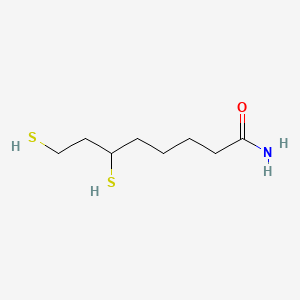| MeSH term | MeSH ID | Detail |
|---|---|---|
| Parkinsonian Disorders | D020734 | 20 associated lipids |
Dihydrolipoamide
Dihydrolipoamide is a lipid of Fatty Acyls (FA) class. Dihydrolipoamide is associated with abnormalities such as Wiskott-Aldrich Syndrome. The involved functions are known as Citric Acid Cycle, Electron Transport, NADH oxidation, Oxidation and Oxidants. Dihydrolipoamide often locates in Mitochondria, Mitochondrial matrix and Chloroplasts. The associated genes with Dihydrolipoamide are Mutant Proteins, Recombinant Proteins, mycothione reductase, Genes, Mitochondrial and alanylproline.
Cross Reference
Introduction
To understand associated biological information of Dihydrolipoamide, we collected biological information of abnormalities, associated pathways, cellular/molecular locations, biological functions, related genes/proteins, lipids and common seen animal/experimental models with organized paragraphs from literatures.
What diseases are associated with Dihydrolipoamide?
Dihydrolipoamide is suspected in and other diseases in descending order of the highest number of associated sentences.
Related references are mostly published in these journals:
| Disease | Cross reference | Weighted score | Related literature |
|---|
Possible diseases from mapped MeSH terms on references
We collected disease MeSH terms mapped to the references associated with Dihydrolipoamide
PubChem Associated disorders and diseases
What pathways are associated with Dihydrolipoamide
There are no associated biomedical information in the current reference collection.
PubChem Biomolecular Interactions and Pathways
Link to PubChem Biomolecular Interactions and PathwaysWhat cellular locations are associated with Dihydrolipoamide?
Visualization in cellular structure
Associated locations are in red color. Not associated locations are in black.
Related references are published most in these journals:
| Location | Cross reference | Weighted score | Related literatures |
|---|
What functions are associated with Dihydrolipoamide?
Related references are published most in these journals:
| Function | Cross reference | Weighted score | Related literatures |
|---|
What lipids are associated with Dihydrolipoamide?
There are no associated biomedical information in the current reference collection.
What genes are associated with Dihydrolipoamide?
Related references are published most in these journals:
| Gene | Cross reference | Weighted score | Related literatures |
|---|
What common seen animal models are associated with Dihydrolipoamide?
There are no associated biomedical information in the current reference collection.
NCBI Entrez Crosslinks
All references with Dihydrolipoamide
Download all related citations| Authors | Title | Published | Journal | PubMed Link |
|---|---|---|---|---|
| Ninomiya M et al. | PBC: Animal Models of Cholangiopathies and Possible Endogenous Viral Infections. | 2012 | Int J Hepatol | pmid:22007316 |
| Sasaki M and Nakanuma Y | Novel approach to bile duct damage in primary biliary cirrhosis: participation of cellular senescence and autophagy. | 2012 | Int J Hepatol | pmid:21994884 |
| Schlüter A et al. | Functional genomic analysis unravels a metabolic-inflammatory interplay in adrenoleukodystrophy. | 2012 | Hum. Mol. Genet. | pmid:22095690 |
| Sandoval JM et al. | Glucose-6-phosphate dehydrogenase protects Escherichia coli from tellurite-mediated oxidative stress. | 2011 | PLoS ONE | pmid:21984934 |
| Wang N et al. | Display of Bombyx mori alcohol dehydrogenases on the Bacillus subtilis spore surface to enhance enzymatic activity under adverse conditions. | 2011 | PLoS ONE | pmid:21738670 |
| Richardson AR et al. | Multiple targets of nitric oxide in the tricarboxylic acid cycle of Salmonella enterica serovar typhimurium. | 2011 | Cell Host Microbe | pmid:21767810 |
| Bhaskaran S et al. | Breaking Caenorhabditis elegans the easy way using the Balch homogenizer: an old tool for a new application. | 2011 | Anal. Biochem. | pmid:21354098 |
| Hall BS et al. | Nifurtimox activation by trypanosomal type I nitroreductases generates cytotoxic nitrile metabolites. | 2011 | J. Biol. Chem. | pmid:21345801 |
| Sianglum W et al. | Proteome analyses of cellular proteins in methicillin-resistant Staphylococcus aureus treated with rhodomyrtone, a novel antibiotic candidate. | 2011 | PLoS ONE | pmid:21326597 |
| Holbrook ED et al. | Definition of the extracellular proteome of pathogenic-phase Histoplasma capsulatum. | 2011 | J. Proteome Res. | pmid:21291285 |
| Leach MD et al. | Molecular and proteomic analyses highlight the importance of ubiquitination for the stress resistance, metabolic adaptation, morphogenetic regulation and virulence of Candida albicans. | 2011 | Mol. Microbiol. | pmid:21269335 |
| Thangthaeng N et al. | Nongradient blue native gel analysis of serum proteins and in-gel detection of serum esterase activities. | 2011 | J. Chromatogr. B Analyt. Technol. Biomed. Life Sci. | pmid:21237726 |
| Vaubel RA et al. | Mutations in the dimer interface of dihydrolipoamide dehydrogenase promote site-specific oxidative damages in yeast and human cells. | 2011 | J. Biol. Chem. | pmid:21930696 |
| Venugopal A et al. | Virulence of Mycobacterium tuberculosis depends on lipoamide dehydrogenase, a member of three multienzyme complexes. | 2011 | Cell Host Microbe | pmid:21238944 |
| Packer L and Cadenas E | Lipoic acid: energy metabolism and redox regulation of transcription and cell signaling. | 2011 | J Clin Biochem Nutr | pmid:21297908 |
| Marie SK and Shinjo SM | Metabolism and brain cancer. | 2011 | Clinics (Sao Paulo) | pmid:21779721 |
| Skapski A et al. | Genome-scale analysis of Mycoplasma agalactiae loci involved in interaction with host cells. | 2011 | PLoS ONE | pmid:21966487 |
| Hirani TA et al. | Asp295 stabilizes the active-site loop structure of pyruvate dehydrogenase, facilitating phosphorylation of ser292 by pyruvate dehydrogenase-kinase. | 2011 | Enzyme Res | pmid:21318135 |
| Katz E et al. | Label-free shotgun proteomics and metabolite analysis reveal a significant metabolic shift during citrus fruit development. | 2011 | J. Exp. Bot. | pmid:21841177 |
| Yao R et al. | Catabolic regulation analysis of Escherichia coli and its crp, mlc, mgsA, pgi and ptsG mutants. | 2011 | Microb. Cell Fact. | pmid:21831320 |
